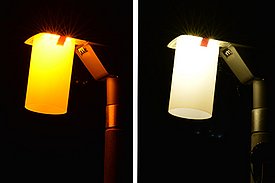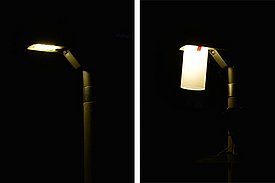Artificial light at night (ALAN) is an important driver of insect decline. In this experiment, we investigate the impact of interacting properties of street luminaires on insect diversity and bat activity in environments that are less influenced by artificial light, i.e. forests.
Cold-white, slightly bluish LED bulbs save energy but attract numerous insects that react to blue light. Due to this supernormal stimulus, insects fail to move away from the light sources and die. This is less pronounced with amber and warm-white light colors (Fig. 1).
The design and shape of LED luminaires also have an influence on how far the light can be perceived and thus possibly impacts insects, but also other living beings.
We are testing two forms of luminaire housing at three locations (Lägeren, Birmensdorf, Alptal). One of them is a standard LED lamp, the other one increases the visibility of the light by means of a diffuser (Fig. 2). We also vary the light color (warm-white, amber, cold-white) and light level (50% or 100%).
We mounted flight-interception traps below the luminaires (Fig. 3) in order to assess the diversity and abundance of flying insects that are attracted by the lights. In addition, we use pitfall traps to capture insects and other invertebrates that dwell on the soil surface. We are interested in whether species with specific characteristics are more strongly influenced by particular light regimes than others.
Bats use ultrasound echolocation for orientation and hunting. With a BATLOGGER, we record their echolocation calls and thus can test for the broader impact on species at the top of the food chain.
The WSL and the Electricity Works of the Canton of Zurich (EKZ) will carry out the experiment together over several years in order to measure the long-term effects of LED lights on insects.
Contact ¶
Links ¶
- "Dimmable LED street-lamps help hardpressed night-lovers": article in WSL magazine DIAGONAL


